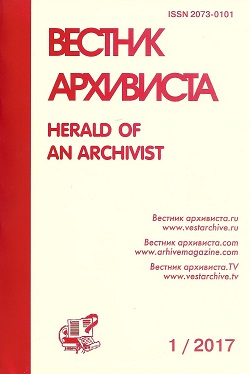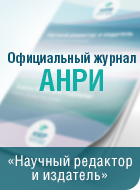Scientific article
УДК 311.313+311.21+314.88+314.02+311.213+311.214+930.253+930.255 +930.24 +311.219.1+311.219.2+311.312+314.422.2
doi 10.28995/2073-0101-2023-2-565-575
Burmatov, Alexander А.
Kuibyshev branch of the Novosibirsk State Pedagogical University, Kuibyshev, Russian Federation
Requests to Statistical Directorates: Potential for Historical and Demographic Research (1950–70).
Abstract
The article considers the possibility of using official requests of scientists to territorial state agencies for statistics in Western Siberia to study the demographic history of the region. The history of the population of the Soviet Union remains poorly studied, despite huge number of works devoted to the topic. During the Soviet period, entire eras were not covered in statistics and science. The authorities hid negative consequences of the modernization and huge losses following wars, famine, and repression. In addition to direct concealment of statistical information, data falsification was widely practiced. The first postwar fifteen years are a typical example of Soviet statistics. There was no published information on the population until 1957. The first post-war estimates dated back to April 1956 and were not confirmed by the 1959 census. After the next census, statistical agencies recalculated the dynamics of the population and all indicators of its natural movement. In the USSR, there was an underestimation of demographic events. This is especially true for the mortality. Statistical agencies collected, rechecked, and clarified the collected data; the information was not only corrected, but also subjected to a comprehensive analysis. Dynamic series on the population and its natural movement by regions and edges were never published. The transfer of statistical materials to the state archives has not yet been conducted in full; the available materials contain large data gaps. Sometimes the data was distorted intentionally or accidentally. Publications of the Central Statistical Administration (TsSU) and statistical directorates for regions and territories sometimes differ. The author has made requests directly to the territorial bodies of state statistics of the regions of Western Siberia. The official responses contained information collected and calculated by the same procedure. Chronological period is 1950–70. The decade of 1950–59 was a period when population data was virtually not published. For the period of 1959–70 there were some fragmentary publications, but they did not give a complete picture. Materials contain data on the population (including urban and rural), absolute number of births, deaths (including children under 1 year old). All materials on urban and rural population are given for the whole region. The responses contain indicators of natural movement, including infant mortality. The peculiarity of the information provided is that all data on absolute numbers and indicators of natural movement are recalculated on the basis of the 1970 census. This makes it possible to compare it with previously published data, especially in collections “for official use.” Thus, the responses of statistical agencies allow us to fill the gaps in the demographic history of the regions of Western Siberia. Western Siberia is considered within the borders of the eponymous economic region at the time of the 1959 census: the Altai Krai, Kemerovo, Novosibirsk, Omsk, and Tomsk regions.
Keywords
Historical sources, Western Siberia, 1959 census in the USSR, 1970 census in the USSR, population statistics, natural population movement, Central Statistical Administration of the Council of Ministers of the USSR and regional statistical directorates.
Download the article: burmatov_doi
References
ANDREYEV, E. M., DARSKII, L. E., KHARKOVA, T. L. The population of the Soviet Union. 1922–91. Moscow, 1993, 143 p.
VOSTRIKOVA, A. M. Sample survey in demographic statistic. IN: BOYARSKY, A. Ya. DZHAPARIDZE, V. V., OVSIENKO, V. S., EIDELMAN, M. R. (eds.). Sample survey in Soviet statistic. Moscow, 1966, pp. 310–327.
GONINA, N. V., PAVLYUKEVICH, R. V., SLAVINA, L. N. Fondy regional'nykh planovykh organov kak naibolee tsennyi istochnik po dinamike i urovnyu zhizni gorodskogo naseleniya Vostochnoi Sibiri. 1954–1984 gg. [Fonds of Regional Planning Agencies as a Most Valuable Source on the Dynamics and Standards of Living of the Urban Population of Eastern Siberia: 1954–84. In Russ.]. IN: Vestnik arhivista / Herald of an Archivist, 2021, no. 4, pp. 1088-1105.
DASHINAMZHILOV, O. B. The urban population of Western Siberia in the 1960s–80s: A historical and demographic study. Novosibirsk, 2018, 366 p.
ZHIROMSKAYA, V. B. Life potential of postwar generations in Russia: Historical and demographic aspect. (1946-60). Moscow, 2009, 277 p.
ZHIROMSKAYA, V. B. The main trends in the demographic development of Russia in the 20th century. Moscow, 2013, 320 p.
Demographic history of Western Siberia (late 19th – 20th century). Novosibirsk, 2017, 350 p.
About the authors
Burmatov Alexander Anatolievich, PhD in History, associate professor, Kuibyshev Branch of Novosibirsk State Pedagogical University, Kuibyshev, Russian Federation, +7-913-756-33-68, This e-mail address is being protected from spambots. You need JavaScript enabled to view it
Submitted 7.10.2022, published (for citation):
BURMATOV, A. A. Zaprosy v statisticheskie upravleniya: potentsial dlya istoriko-demograficheskikh issledovanii 1950-1970 gg. [Requests to Statistical Directorates: Potential for Historical and Demographic Research (1950–70). In Russ.]. IN: Vestnik arhivista / Herald of an Archivist, 2023, no. 2, pp. 565-575. doi 10.28995/2073-0101-2023-2-565-575














